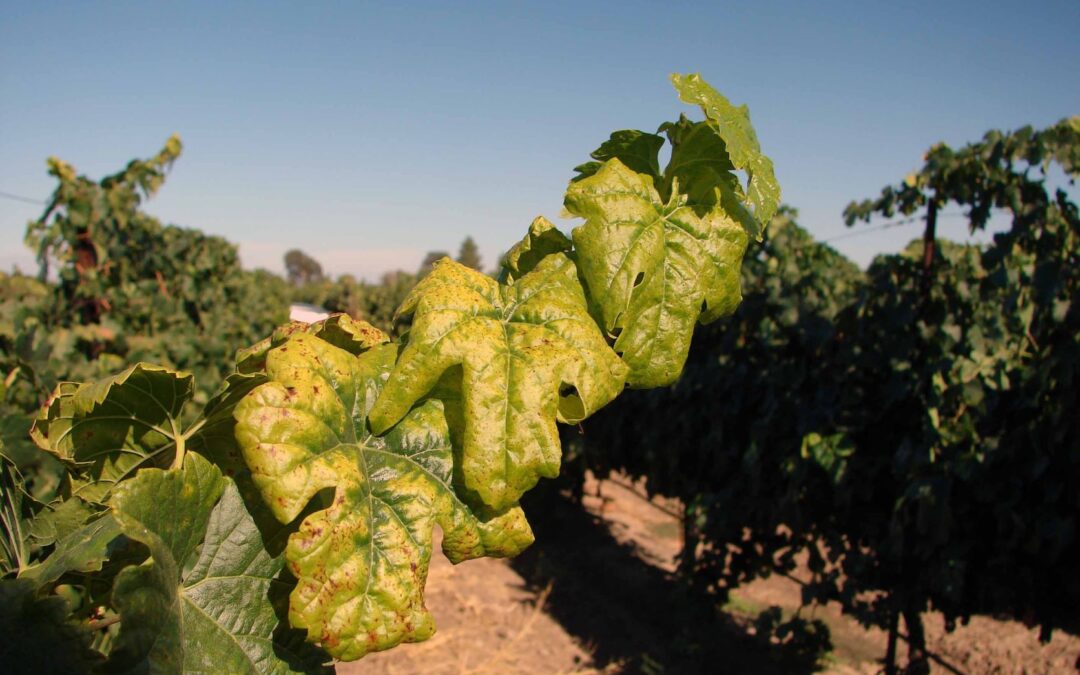SEPTEMBER 17, 2018. BY STEPHANIE BOLTON & STAN GRANT.
Every conversation between Lodi growers right now includes some sort of theory on why we’re seeing more potassium (K+) deficiency than anyone can remember.
We discussed it at our monthly PCA Network Breakfast Meeting on September 4th (which you are all invited to, by the way – we meet on the first Tuesday morning of every month at Burgundy Hall, Lodi Grape Festival Grounds, from 7:30-9am, and offer 1.5 hrs of DPR CE credits). A few of us discussed it during a sunrise harvest in Acampo. It’s common talk at the morning diner over coffee. Heck, if you’re reading this right now you probably have your own theory!
Most potassium deficiency theories have something to do with the abnormal weather we’ve been having. Is it because of the wildfires? The floods last year? The uneven ripening? Other theories point towards farming practices. Did some growers not prepare for the above-average crop? Is it because potassium is applied through drip irrigation these days as opposed to the old system of potash – and the deficiency is just now coming to light?
Tired of playing the guessing game, we reached out to our trusted, logical source for grapevine nutrient knowledge – Stan Grant. Here’s what he has to say:
“I think that the potassium deficiency we are seeing in the Lodi region has to do mainly with timing.” Veraison came late this year. Then, we saw a few weeks where there was a big surge of sugar from the leaves into the clusters. To power this sugar surge, the berries took a lot of potassium from the most recently developed leaves. In essence, the fruit robbed the canopy of it’s potassium.

Fig. 1: Typical symptoms of potassium deficiency appear on mid shoot leaves as a faint chlorosis, often with speckles of dead tissues. Such leaves are most common on the afternoon sun sides of canopies. (Progressive Viticulture©)

Fig. 2: When crop loads are heavy, ripening period potassium deficiency symptoms appear on a few apical leaves. Symptomatic leaves sometimes cup downwards. (Progressive Viticulture©)
In normal years, we may see potassium deficiency on mid shoot leaves (Fig. 1) or if the crop is heavy during ripening, on a few leaves at the apical ends of shoots (Fig. 2). This year, however, we are seeing potassium deficiency sometimes extending downwards from the shoot apex on several leaves. As the potassium rushed to the fruit during the abnormal speedy ripening process, the leaves turned chlorotic and we all got a Viticulture 101 lesson in potassium deficiency symptoms (Fig. 3).

Fig. 3: In many vineyards this year, ripening period potassium deficiency symptoms were more extensive than normal, involving several leaves on the apical ends of shoots. (Progressive Viticulture©)
Potassium deficient leaves are less than fully hydrated. Perhaps more important, the stomata on the grapevine leaves require potassium to open and close effectively, which is a necessary function for leaf cooling. So when potassium is deficient in leaves, they more easily succumb to heat damage (Fig. 4).

Fig. 4: Potassium deficiency makes leaves more prone to heat damage, which was evident in some vineyards during the ripening period this year. (Progressive Viticulture©)
So, what to do about potassium deficiency now and next year? Many growers are applying potassium if their crop is still ripening. For next year, be sure to do a petiole or blade analysis at bloom and veraison and adjust the fertigation program accordingly. And remember the crop has a high demand for potassium.
Have something interesting to say? Consider writing a guest blog article!
To subscribe to the Coffee Shop Blog, send an email to stephanie@lodiwine.com with the subject “blog subscribe.”
To join the Lodi Growers email list, send an email to stephanie@lodiwine.com with the subject “grower email subscribe.”
To receive Lodi Grower news and event promotions by mail, send your contact information to stephanie@lodiwine.com or call 209.367.4727.
For more information on the wines of Lodi, visit the Lodi Winegrape Commission’s consumer website, lodiwine.com.


